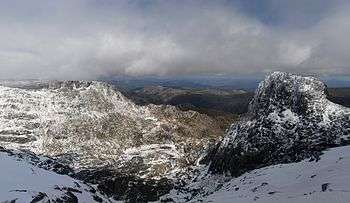Nunatak


A nunatak (from Inuit nunataq) is an exposed, often rocky element of a ridge, mountain, or peak not covered with ice or snow within (or at the edge of) an ice field or glacier. They are also called glacial islands.[2]
The word is of Greenlandic origin[3] and has been used in English since the 1870s.
Description
The term is typically used in areas where a permanent ice sheet is present and the nunataks protrude above the sheet.[4] Nunataks present readily identifiable landmark reference points in glaciers or ice caps and are often named. While some nunataks are isolated, sometimes they form dense clusters, such as Queen Louise Land in Greenland.[5]
Nunataks are generally angular and jagged, which hampers the formation of glacial ice on their tops, although snow can accumulate on them. They usually contrast strongly with the softer contours of the glacially eroded land after a glacier retreats.
Typically nunataks are the only places where plant life can survive on the ice sheets or ice caps. Lifeforms on nunataks are frequently isolated by the surrounding ice or glacier, which contributes to provide unique habitats.[6]
List
- Aitken Nunatak
- Åkerlundh Nunatak
- Altsek Nunatak
- Anoritooq
- Appalachia Nunataks
- Atanasoff Nunatak
- Aviator Nunatak
- Belknap Nunatak
- Berg Mountains
- Bon Docteur Nunatak
- Bradley Nunatak
- Branson Nunatak
- Cameron Nunataks
- Canisp, formed as a Nunatak
- Castillo Nunatak
- Cathedral Peak, California, USA
- C. H. Ostenfeld Nunatak
- Cheeks Nunatak
- Drury Nunatak
- Du Toit Nunataks
- Eaton Nunatak
- Exile Nunatak
- Exiles Nunataks
- Faraway How
- Gora Severny Nunatak
- Gronau Nunataks
- Grossman Nunataks
- Guardian Nunatak
- Hamner Nunatak
- Harvey Nunataks
- Jane Peak
- Jutulsessen
- Klawatti Peak
- Lacroix Nunatak
- Lands End Nunataks
- Lawson Nunatak
- Lawson Nunataks
- Lodalskåpa
- López Nunatak
- MacDonald Nunataks
- Marujupu Peak
- Meade Nunatak
- Meyers Nunatak
- Mulgrew Nunatak
- Newman Nunataks
- Nødtvedt Nunataks
- Nunatakassak
- Nunatarsuaq
- Nunatarsuaq (Tasiusaq Bay)
- Olson Nunatak
- Orsugissap Qaqqarsua
- Packsaddle Island
- Price Nunatak
- Queen Louise Land
- Quest Nunatak
- Robertson Nunatak
- Schloredt Nunatak
- See Nunatak
- Shelton Nunataks
- Ship Nunatak
- Shoemake Nunatak
- Stac Pollaidh, formed as a Nunatak
- Starr Nunatak
- Stinear Nunataks
- Suilven, formed as a Nunatak
- Svarthamaren Mountain
- Symes Nunatak
- Syningen Nunatak
- Tommeliten Rock
- Trioen Nunataks
- Tuttulikassak
- Utsteinen Nunatak
- Velchev Rock
- Vesleskarvet
- Wandel Land
- Watkins Range
- Whichaway Nunataks
- White Nunataks
- Willan Nunatak
- Windscoop Nunataks
- Yingling Nunatak
- Young Nunataks
- Zohn Nunataks
See also
References
- ↑ Vieira, G.T.; Ferreira, A.B. (1998). "General characteristics of the glacial geomorphology of the Serra da Estrela". In G.T. Vieira. Glacial and Periglacial Geomorphology of the Serra da Estrela. Guidebook for the field-trip IGU Commission on Climate Change and Periglacial Environments, 26-28 August1998 (PDF). pp. 37–48. Retrieved October 16, 2011.
- ↑ Physical Geography: Hydrosphere, 2006, ISBN 8183561675, p. 114
- ↑ "Merriam-Webster: nunatak". Retrieved October 16, 2011.
- ↑ J. J. Zeeberg, Climate and Glacial History of the Novaya Zemlya Archipelago, Russian Arctic. pp. 82-84
- ↑ "Dronning Louise Land". Mapcarta. Retrieved 2 July 2016.
- ↑ ice cap - National Geographic Society
External links
 Media related to Nunatak at Wikimedia Commons
Media related to Nunatak at Wikimedia Commons- Nunatak survival of the high Alpine plant Eritrichium nanum